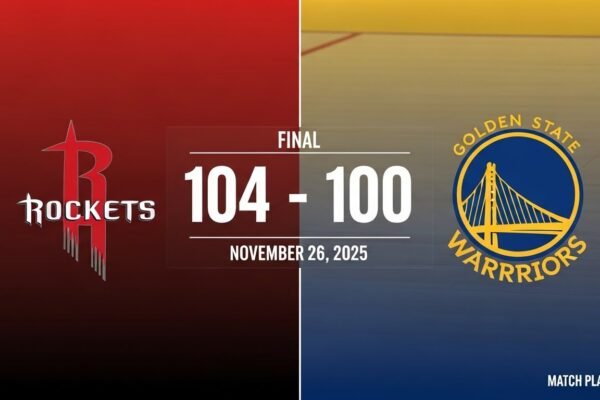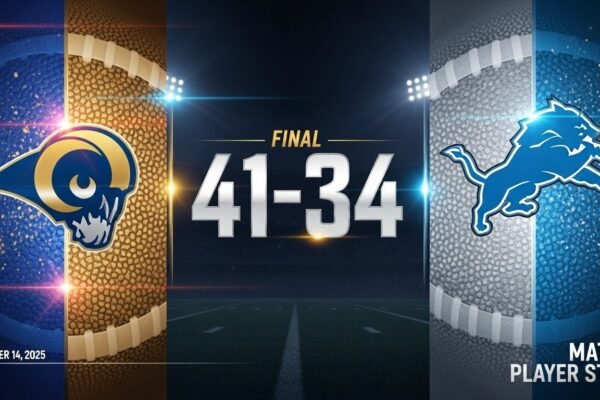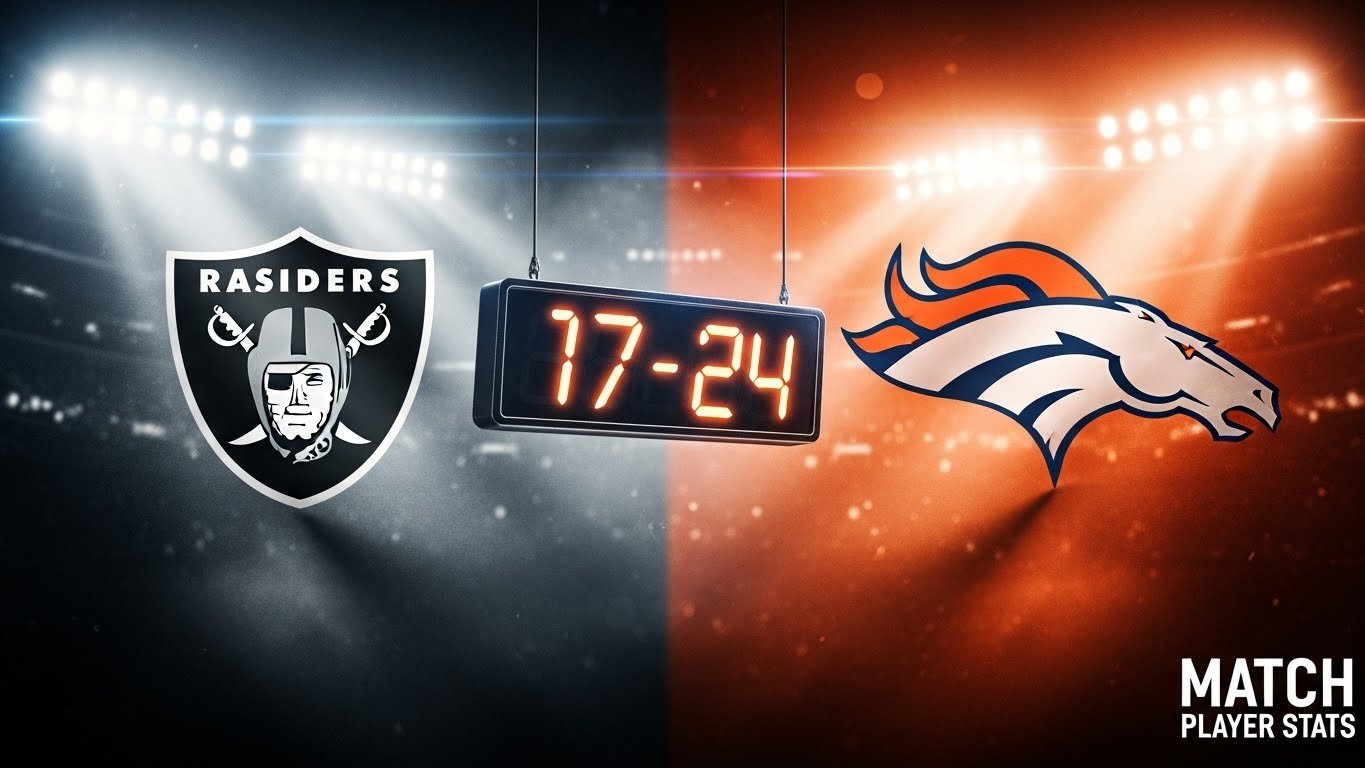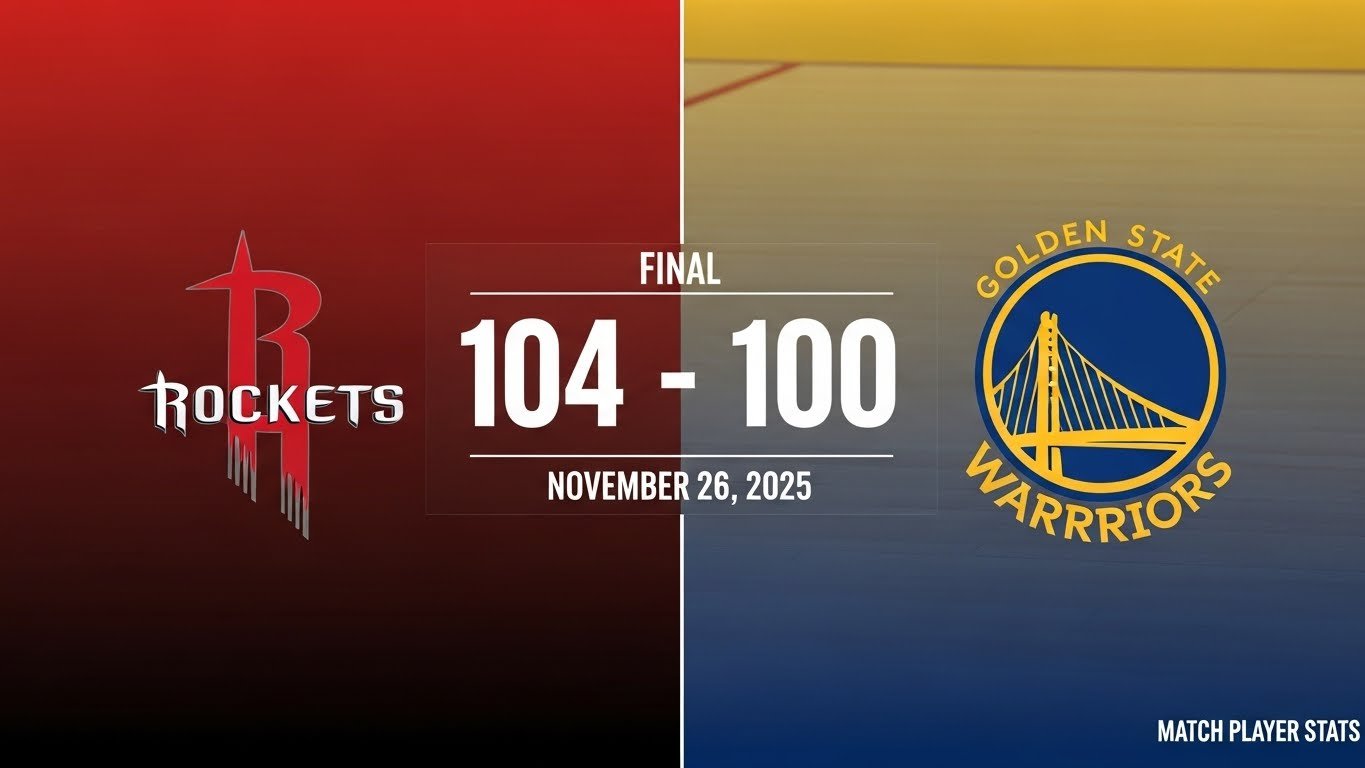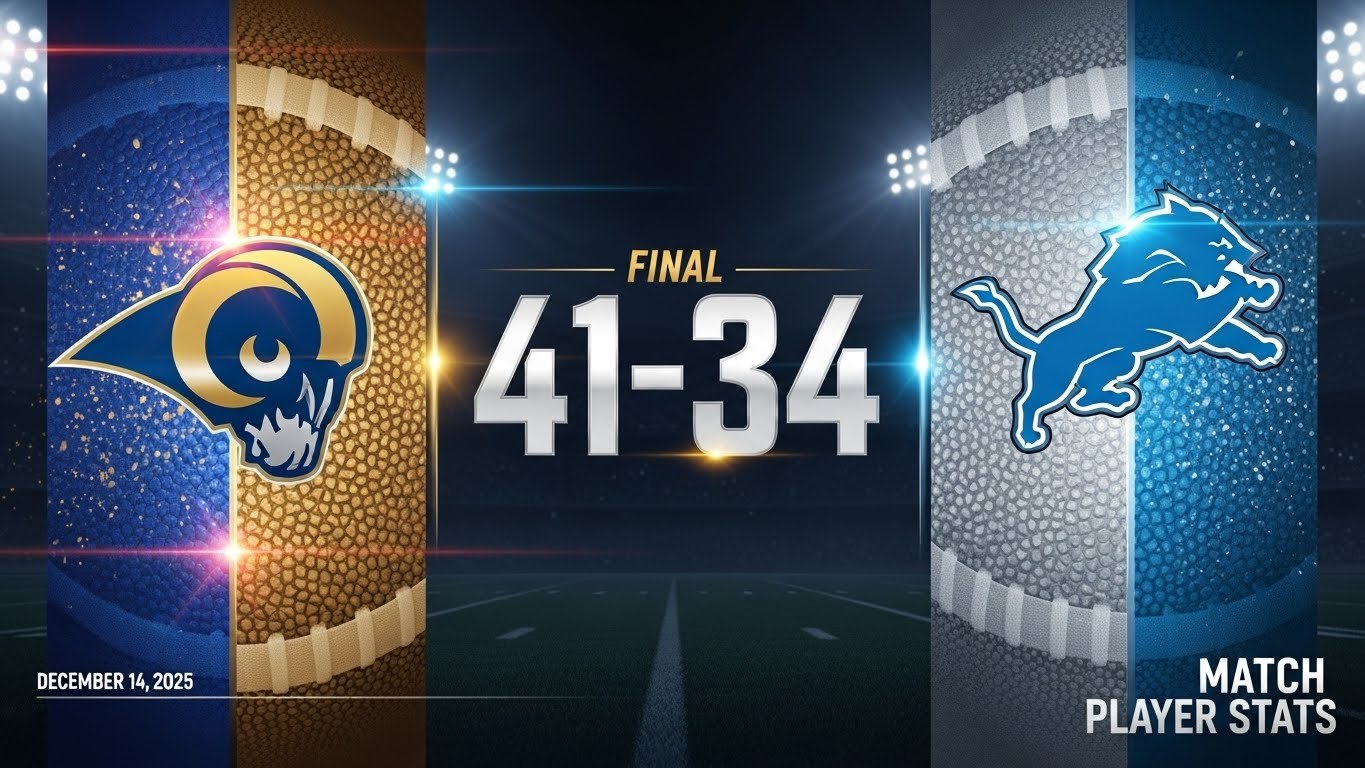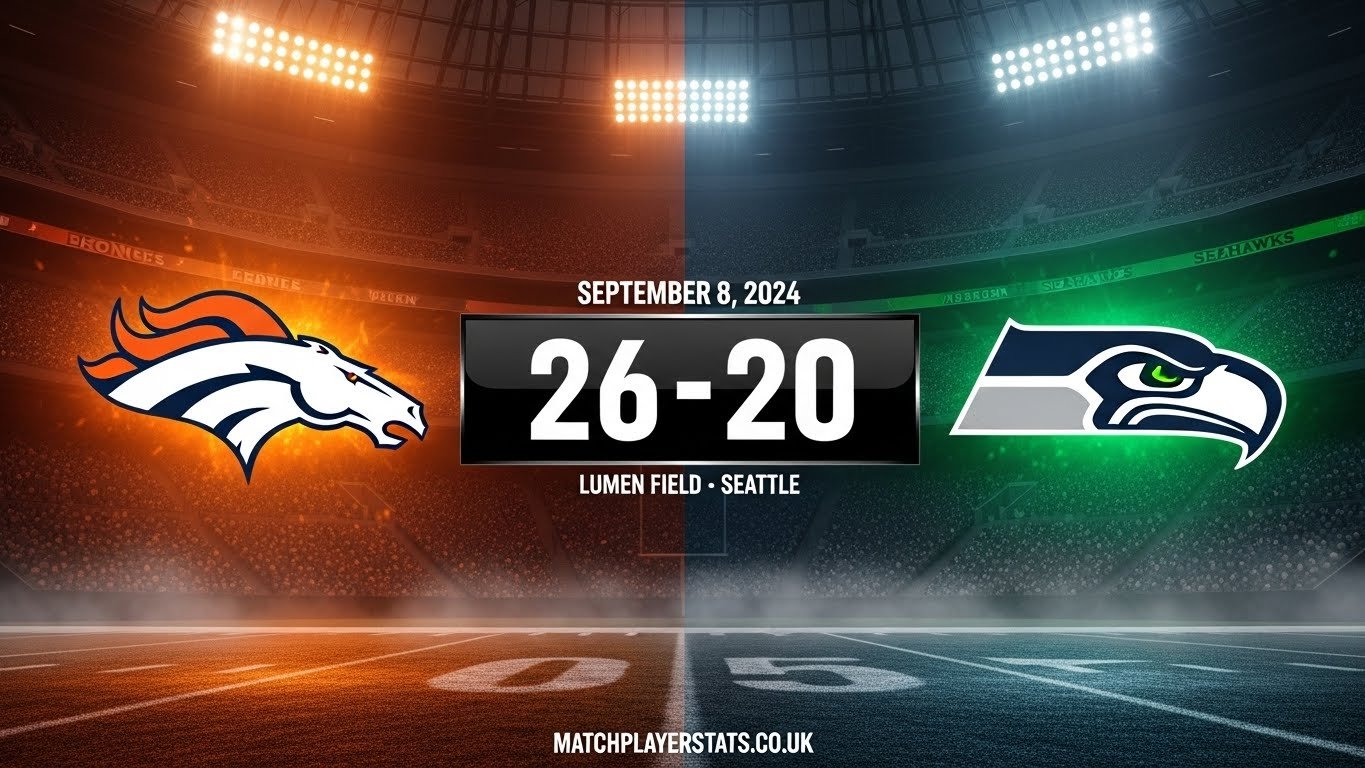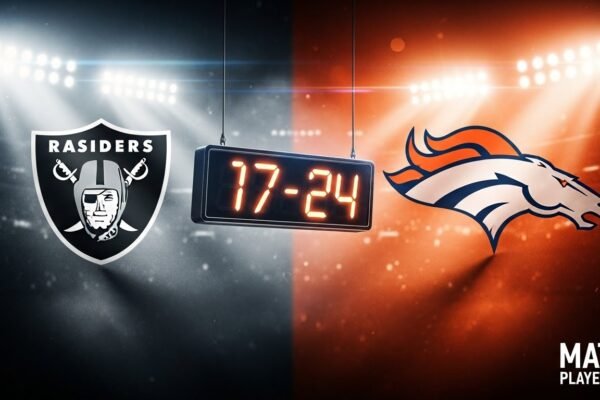
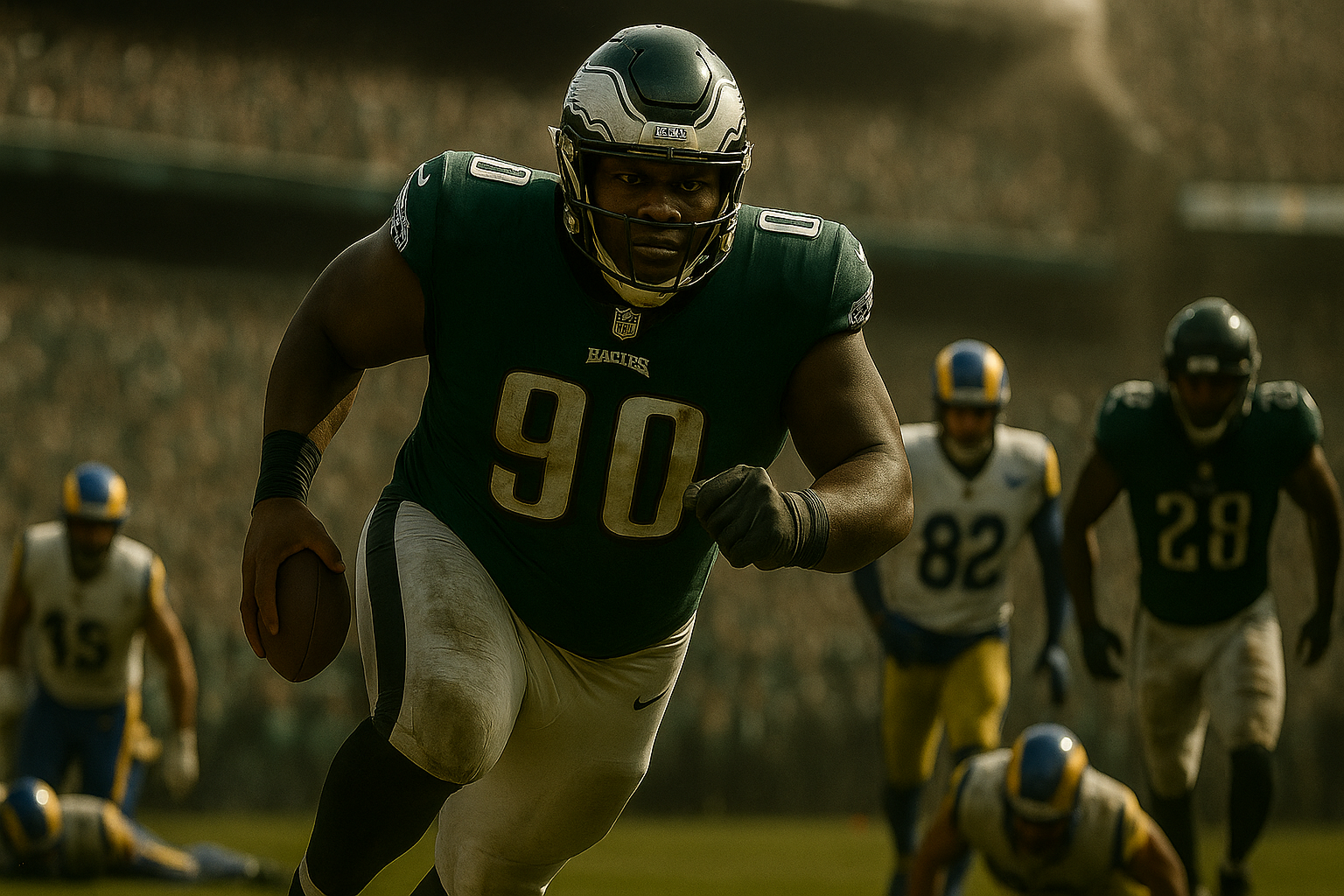
Philadelphia Eagles vs Los Angeles Rams Match Player Stats (Sep 21, 2025)
Jordan Davis clutched the football in his outstretched right hand as he reached the end zone at Lincoln Financial Field. The 336-pound defensive tackle had just returned a blocked field goal 61 yards for a touchdown as time expired, sealing Philadelphia’s improbable 33-26 comeback victory over Los Angeles on September 21, 2025.
The defending Super Bowl champions erased a 19-point deficit against a Rams team that controlled the game for three quarters. Critical moments, halftime adjustments, and one of the most spectacular endings in recent NFL memory decided this game.
Table of Contents
Quick Game Summary
Final Score: Philadelphia 33, Los Angeles 26
Location: Lincoln Financial Field, Philadelphia, PA
Attendance: 69,879
Top Performers:
- Jordan Davis: Game-winning 61-yard blocked FG return TD
- Puka Nacua: 11 catches, 112 yards
- Jalen Hurts: 21/32, 226 yards, 3 pass TD, 1 rush TD
- Matthew Stafford: 19/33, 196 yards, 2 TD, 1 INT
- Kyren Williams: 20 carries, 94 yards
Game-Changing Stats:
- Eagles 4th down: 4-for-5 (80%)
- Rams 4th down: 0-for-1 (0%)
- Red zone TDs: PHI 3-for-3 (100%), LAR 1-for-4 (25%)
How The Scoring Happened
| Quarter | Time | Team | Play | Score |
|---|---|---|---|---|
| Q1 | 8:07 | PHI | Hurts 1-yard run (Elliott XP) | 0-7 |
| Q1 | 4:00 | LAR | Karty 51-yard FG | 3-7 |
| Q1 | 1:20 | LAR | Adams 44-yard TD from Stafford (Karty XP) | 10-7 |
| Q2 | 9:15 | LAR | Karty 28-yard FG | 13-7 |
| Q2 | 3:43 | LAR | Karty 33-yard FG | 16-7 |
| Q2 | 0:10 | LAR | Karty 46-yard FG | 19-7 |
| Q3 | 14:06 | LAR | K. Williams 10-yard TD from Stafford (Karty XP) | 26-7 |
| Q3 | 11:38 | PHI | Goedert 33-yard TD from Hurts (Elliott XP) | 26-14 |
| Q3 | 2:16 | PHI | A.J. Brown 9-yard TD from Hurts (Elliott XP) | 26-21 |
| Q4 | 1:48 | PHI | D. Smith 4-yard TD from Hurts (pass failed) | 26-27 |
| Q4 | 0:00 | PHI | Davis 61-yard blocked FG return | 26-33 |
Conditions: 73°F, 47% humidity, wind 9 mph. Referee Brad Rogers. Eagles won coin toss and deferred. Philadelphia covered as 3-point underdogs (CBS Sports broadcast).
The Injury That Changed Everything
Lane Johnson crumpled to the turf during Philadelphia’s opening drive. The All-Pro right tackle grabbed his neck and was immediately escorted to the sideline. Matt Pryor jogged onto the field to replace him. On the Rams sideline, defensive coordinator Chris Shula saw opportunity.
Through the next two quarters, Los Angeles attacked Pryor relentlessly. Jared Verse, Byron Young, and Poona Ford took turns exploiting the backup tackle. Philadelphia’s offense generated just 33 total yards in the first half. Hurts completed 4 of 8 passes for 17 yards. The Rams defense recorded three sacks and constant pressure.
Fourteen consecutive plays produced minus-3 net yards. Los Angeles built a 19-7 halftime lead by targeting Philadelphia’s right side. Inside the visitors’ locker room, adjustments were being drawn up.
Fred Johnson’s Zero-Practice Miracle
Fred Johnson had taken zero practice reps at right tackle during the week. Acquired via trade before the season, he stood on the sideline as the coaches approached. The message was simple: you’re going in.
Johnson trotted onto the field for the second half. His first snap protection held. His second snap protection held. By his third series, Hurts had time to scan the field. The difference was night and day.
Over the final two quarters, Hurts completed 17 of 24 passes for 209 yards and three touchdowns. Philadelphia allowed just one more sack. Johnson’s emergency performance, combined with the switch to no-huddle offense, neutralized Los Angeles’s pass rush advantage.
The no-huddle tempo prevented defensive substitutions. After using it on one play in the first half, Philadelphia ran no-huddle on 53.7% of their second-half snaps. Los Angeles couldn’t adjust personnel packages or make complex pre-snap calls. The Rams defense that dominated for two quarters suddenly had no answers.
Pro Football Focus named Philadelphia’s offensive line Team of the Week. Jordan Mailata earned Offensive Player of the Week honors with a 94.5 overall grade (95.6 run-blocking). All five starters played every offensive snap: Mailata, Landon Dickerson, Cam Jurgens, Mekhi Becton, and Johnson.
First Half vs Second Half Impact
| Statistic | With Pryor (1st Half) | With Johnson (2nd Half) |
|---|---|---|
| Passing Yards | 17 | 209 |
| Completions/Attempts | 4/8 | 17/24 |
| Touchdowns | 0 | 3 |
| Sacks Allowed | 3 | 1 |
| Passer Rating | 56.2 | 135.6 |
Philadelphia’s coaches identified the problem and fixed it at halftime. That adjustment won the game.
Jalen Hurts: Complete Quarterback Performance
Hurts finished 21-of-32 for 226 yards, three passing touchdowns, and zero interceptions (117.4 rating). He added 40 rushing yards and one rushing touchdown on nine carries.
Complete Passing Stats:
- Completions/Attempts: 21/32 (65.6%)
- Passing Yards: 226
- Touchdowns: 3
- Interceptions: 0
- Yards Per Attempt: 7.1
- Passer Rating: 117.4
- Sacks: 4 for 24 yards lost
- Average Depth of Target: 9.2 yards
Seven of nine deep passes (20+ air yards) connected for 154 yards and two scores in the second half. Hurts attacked vertically when Johnson gave him time, then went underneath when Los Angeles dropped extra defenders. His 33-yard touchdown to Dallas Goedert at 11:38 in the third quarter started the comeback, cutting the Rams’ lead to 26-14.
The Super Bowl MVP threw touchdown passes to three different receivers: Goedert (33 yards), A.J. Brown (9 yards), and DeVonta Smith (4 yards on 4th-and-goal).
Target Distribution
| Receiver | Targets | Catches | Yards | Avg | Long | TD |
|---|---|---|---|---|---|---|
| A.J. Brown | 10 | 6 | 109 | 18.2 | 38 | 1 |
| DeVonta Smith | 9 | 8 | 60 | 7.5 | 16 | 1 |
| Dallas Goedert | 2 | 1 | 33 | 33.0 | 33 | 1 |
| Saquon Barkley | 5 | 4 | 9 | 2.3 | 5 | 0 |
| John Metchie III | 1 | 1 | 8 | 8.0 | 8 | 0 |
| Jahan Dotson | 3 | 1 | 7 | 7.0 | 7 | 0 |
Brown drew extra attention with DeVonta Smith returning from injury. He caught 6 of 10 targets, including two crucial third-down conversions on the game-winning drive. Smith led all receivers with 8 catches. His 4-yard touchdown reception on 4th-and-goal gave Philadelphia a 27-26 lead with 1:48 remaining.
Matthew Stafford’s Milestone Performance
Stafford executed Los Angeles’s game plan brilliantly through three quarters. Nineteen of 33 passes connected for 196 yards, two touchdowns, and one early interception (82.4 rating).
Complete Passing Stats:
- Completions/Attempts: 19/33 (57.6%)
- Passing Yards: 196
- Touchdowns: 2
- Interceptions: 1
- Yards Per Attempt: 5.9
- Passer Rating: 82.4
- Sacks: 1 for 0 yards lost
- Average Depth of Target: 8.3 yards
His 44-yard touchdown strike to Davante Adams in the first quarter put Los Angeles ahead 10-7. His 10-yard touchdown pass to Kyren Williams early in the third quarter, coming immediately after Jared Verse’s strip sack of Hurts, pushed the lead to 26-7.
During the contest, Stafford passed Matt Ryan for ninth place on the NFL’s all-time passing touchdowns list with 382. He became the fourth player in history with 15,000-plus passing yards and 100-plus passing touchdowns with multiple teams, joining Peyton Manning, Carson Palmer, and Jared Goff.
But Philadelphia’s defense shut him down in the fourth quarter when the game was decided.
Stafford’s Targets
| Receiver | Targets | Catches | Yards | Avg | Long | TD |
|---|---|---|---|---|---|---|
| Puka Nacua | 15 | 11 | 112 | 10.2 | 20 | 0 |
| Davante Adams | 8 | 3 | 56 | 18.7 | 44 | 1 |
| Kyren Williams | 3 | 2 | 18 | 9.0 | 10 | 1 |
| Jordan Whittington | 3 | 2 | 7 | 3.5 | 9 | 0 |
| Davis Allen | 1 | 1 | 3 | 3.0 | 3 | 0 |
Puka Nacua caught 11 of 15 targets for 112 yards, serving as Stafford’s safety valve throughout. Adams showed his elite ability on the 44-yard touchdown but managed just three total receptions as Philadelphia’s secondary adjusted.
Ground Game Production
Complete Rushing Stats
| Running Back | Team | Carries | Yards | Avg | Long | TD | Receptions | Rec Yards |
|---|---|---|---|---|---|---|---|---|
| Kyren Williams | LAR | 20 | 94 | 4.7 | 13 | 0 | 2 | 18 |
| Saquon Barkley | PHI | 18 | 46 | 2.6 | 12 | 0 | 4 | 9 |
| Blake Corum | LAR | 8 | 53 | 6.6 | 12 | 0 | 0 | 0 |
| Jalen Hurts | PHI | 9 | 40 | 4.4 | 18 | 1 | 0 | 0 |
Kyren Williams rushed 20 times for 94 yards, consistently gaining positive yardage and averaging 4.7 yards per carry. He caught two passes for 18 yards, including the 10-yard touchdown reception. Blake Corum provided a spark off the bench with 53 yards on 8 carries, averaging 6.6 yards per attempt.
Saquon Barkley managed just 46 yards on 18 carries against Los Angeles’s defense, averaging 2.6 yards per attempt with a long of only 12 yards. After torching this same Rams defense for 255 yards and two touchdowns in their November 2024 matchup, then following up with 205 yards and two more scores in the playoff rematch, Barkley found no running room this time. He caught 4 passes for 9 yards but couldn’t generate explosive plays.
But Barkley’s real contributions came on the game-winning drive. His receptions helped sustain possession during the crucial 17-play march that put Philadelphia ahead. His work in pass protection also proved valuable in the second half when Fred Johnson stabilized the offensive line.
The 336-Pound Game-Wrecker
Jordan Davis’s performance went beyond just the final play. Three moments defined his afternoon.
Early in the fourth quarter, Davis stuffed Kyren Williams on 4th-and-1 at Philadelphia’s 47-yard line. The stop gave the Eagles offense the ball and prevented Los Angeles from draining additional clock.
With 8:42 remaining, Davis’s interior presence helped disrupt the protection on a 36-yard field goal attempt that Jalen Carter blocked.
Then came the moment that will be replayed for decades. With three seconds on the clock and Joshua Karty attempting a potential game-winning 44-yard field goal, Davis wedged through the interior. He thrust his arm upward, blocking the kick. The ball fell to the turf. Davis scooped it up and rumbled 61 yards for a touchdown as time expired.
According to Next Gen Stats, Davis reached a top speed of 18.59 mph on the return, the fastest speed recorded by a player over 330 pounds since at least 2017. He became the heaviest player in NFL history to return a blocked kick 50-plus yards for a touchdown.
Davis lost 26 pounds during the offseason to improve his conditioning. That dedication allowed him to remain dominant deep into the fourth quarter when everything was on the line.
Defensive Control
Philadelphia’s defense allowed 356 yards but made stops when necessary. The unit held Los Angeles scoreless in the fourth quarter and generated constant pressure.
Tackle Leaders
| Player | Team | Position | Total | Solo | Sacks | TFL | QB Hits | PD |
|---|---|---|---|---|---|---|---|---|
| Cooper DeJean | PHI | CB | 9 | 5 | 0 | 1 | 0 | 0 |
| Kam Curl | LAR | S | 9 | 6 | 0 | 0 | 0 | 0 |
| Jihaad Campbell | PHI | LB | 8 | 5 | 0 | 0 | 0 | 0 |
| Zack Baun | PHI | LB | 7 | 3 | 0 | 0 | 0 | 2 |
| Jared Verse | LAR | OLB | 6 | 4 | 1 | 2 | 1 | 0 |
| Kamren Kinchens | LAR | S | 7 | 4 | 0 | 0 | 0 | 1 |
| Quentin Lake | LAR | S | 6 | 2 | 0 | 0 | 0 | 4 |
Zack Baun played every defensive snap (72/72, 100%) and intercepted Stafford on Los Angeles’s opening drive. Isaiah Rodgers and C.J. Gardner-Johnson also played every snap. The continuity showed.
Jalen Carter missed just one snap (71/72, 99%) and wreaked havoc from the defensive tackle position. Philadelphia’s defensive strategy centered on preventing explosive plays while generating pressure without blitzing. It worked. Los Angeles gained yards between the 20-yard lines but couldn’t finish drives. Carter’s block of the 36-yard field goal attempt kept the deficit at five points and set up the game-winning drive.
Pass Rush Production
Philadelphia generated 20 total pressures (4 sacks allowed on Hurts, 7 QB hits, 14 hurries) while the defense recorded 1 sack on Stafford.
Eagles Defensive Sacks:
- Jordan Davis: 1.0 sack (0 yards)
Rams Sacks on Hurts:
- Jared Verse: 1.0 sack
- Byron Young: 1.0 sack
- Poona Ford: 1.0 sack
- Jaylen McCollough: 1.0 sack
Los Angeles recorded four sacks on Hurts for 24 yards lost. The difference in sack production and timing proved decisive. Philadelphia’s defense made its lone sack count in a critical moment when Davis chased down Stafford in the third quarter at the Rams’ 49-yard line, forcing a punt that set up an Eagles scoring drive.
Special Teams Collapse
Joshua Karty made his first four field goal attempts: 51, 28, 33, and 46 yards. He converted both extra point attempts, scoring 14 of Los Angeles’s 26 points. Then everything collapsed in the fourth quarter.
Kicking Stats:
| Kicker | Team | FG Made/Att | Long | XP Made/Att | Points |
|---|---|---|---|---|---|
| Jake Elliott | PHI | 0/0 | 0 | 3/3 | 3 |
| Joshua Karty | LAR | 4/6 | 51 | 2/2 | 14 |
Jalen Carter blocked a 36-yard attempt with 8:46 remaining. Davis blocked the final 44-yard try as time expired, returning it for the game-winning touchdown. Two blocked kicks in one quarter destroyed Los Angeles’s chances.
Punting & Returns:
| Category | Rams | Eagles |
|---|---|---|
| Punting Average | 36.0 (1 punt) | 55.5 (4 punts) |
| Punt Return Average | 13.3 (4 returns) | 0.0 (0 returns) |
| Kickoff Return Average | 23.0 (5 returns) | 11.0 (5 returns) |
Braden Mann’s punting gave Philadelphia a significant field position advantage, averaging nearly 20 yards more per punt than Ethan Evans. Xavier Smith returned 4 punts for 53 yards (long of 20) for Los Angeles. Blake Corum returned 5 kickoffs for 115 yards (long of 27) for the Rams. John Metchie and Tank Bigsby combined for 5 kickoff returns totaling 55 yards for Philadelphia.
Team Statistics: Efficiency Beats Volume
| Category | Rams | Eagles |
|---|---|---|
| Total Yards | 356 | 288 |
| First Downs | 22 | 19 |
| Yards Per Play | 5.4 | 4.6 |
| 3rd Down | 3-10 (30%) | 5-14 (36%) |
| 4th Down | 0-1 (0%) | 4-5 (80%) |
| Red Zone TDS | 1-4 (25%) | 3-3 (100%) |
| Turnovers | 1 | 1 |
| Penalties | 4-41 | 5-50 |
| Time of Possession | 29:25 | 30:35 |
Los Angeles outgained Philadelphia 356-288 and held the ball for 29:25. None of it mattered because Philadelphia converted when it counted most.
The Eagles went 4-for-5 on fourth down (80%) while Los Angeles went 0-for-1. Philadelphia scored touchdowns on 3 of 3 red zone trips (100%) while the Rams managed just 1 touchdown in 4 red zone attempts (25%). That 75-point gap in red zone touchdown percentage directly impacted the final margin.
Los Angeles moved the ball between the 20-yard lines. Philadelphia finished drives with touchdowns. The difference was that simple.
The 17-Play, 91-Yard March
Backed up at their own 9-yard line following the taunting penalty on Jalen Carter’s blocked field goal, Philadelphia faced 8:42 on the clock and a five-point deficit. What followed was football at its best.
Seventeen plays. Ninety-one yards. Six minutes and 54 seconds consumed. Los Angeles never touched the ball again.
Critical Conversions:
- 3rd-and-10 at PHI 9: Hurts to Brown, 25 yards
- 3rd-and-3 at LA 48: Hurts to Smith, 10 yards
- 3rd-and-10 at LA 38: Hurts to Brown, 23 yards
- 3rd-and-3 at LA 8: Barkley rush, 4 yards
- 4th-and-goal at LA 4: Hurts to Smith, TD
Brown’s two conversions on third-and-10 were crucial. His violent stiff-arm on Darious Williams broke a tackle on the first conversion. His 23-yard reception on the second moved the Eagles into scoring position with under five minutes remaining. Barkley’s 4-yard run on 3rd-and-3 set up the critical fourth down decision.
Sirianni went for the touchdown on 4th-and-goal rather than kicking a field goal to tie. Hurts delivered under pressure. Smith created separation. Touchdown.
Standings Impact
Philadelphia improved to 3-0 and maintained the NFC’s top seed. Los Angeles fell to 2-1 despite controlling the game for three quarters. Both teams faced challenging schedules ahead.
According to Pro Football Reference, Philadelphia’s 19-1 record over their last 20 games (including playoffs) represented the best 20-game stretch in franchise history. This comeback victory was another example of why.
For Los Angeles, questions about finishing close games resurfaced. The Rams can compete with anyone in the NFC, but protecting leads and converting red zone opportunities must improve. Four field goals kept Philadelphia within striking distance when knockout touchdowns were available.
Historic Comeback Context
The comeback ranked among the largest in Lincoln Financial Field history. Only a 20-point rally against Dallas in 1988 at Veterans Stadium exceeded this 19-point deficit. This marked Philadelphia’s 12th consecutive home victory, the longest active streak in the NFL at the time.
The Eagles overcame injury, poor first-half execution, and a significant deficit through coaching adjustments and player execution. Nothing came easy, but they found a way.
Final Analysis
Philadelphia defeated Los Angeles 33-26 in front of 69,879 fans at Lincoln Financial Field. The Eagles rallied from a 19-point deficit through offensive line adjustments, up-tempo play calling, and defensive stops in critical moments.
Jordan Davis’s 61-yard blocked field goal return as time expired provided one of the most spectacular finishes in recent NFL memory. Los Angeles controlled 45 minutes of this contest and built a comfortable lead. Three seconds later, they walked off the field in disbelief.
The defending champions showed their championship mettle. Philadelphia’s ability to adjust, execute, and perform in high-leverage situations proved the difference between 3-0 and 2-1.
The 2025 season was young, but this September Sunday already stood out as one of its defining days. These teams might meet again in January. If they do, expect another war.

